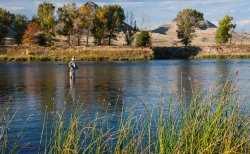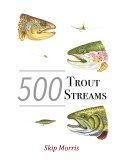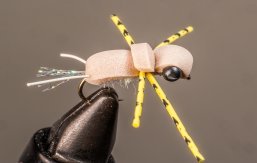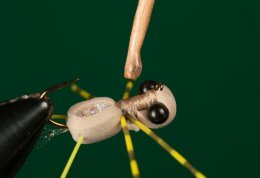Sorting Out Dubbing
Fly materials must make the new fly tier dizzy. Take dubbing. It's a natural or synthetic fur or fiber that's spun onto thread and then wound onto hooks to make fly–bodies, fly–heads, and such—and it comes in lots of varieties, ranging from coarse to fine, dull to sparkling, short– to long–fibered, and so on.
Confusing?
Indeed!
Let's sort it all out then.
And dubbing is worth sorting out, because few (if any) other materials are used as often as dubbing in tying flies.
For starters, so that you know what I'm talking about, so you know what other fly tiers are talking about, and just to protect your short–term sanity, I need to tell you that dubbing is a noun, a thing (that natural or synthetic fur I mentioned), and it's also two verbs, or actions, referring to 1. the process of spinning dubbing–fibers onto thread, and 2. winding the fiber–layered thread onto a hook. So now, if someone says they're going to “dub the working thread with dubbing and then dub a fly–body,” you'll understand. . . maybe, if you think about it for a while.
I see dubbing (the thing) as coming in two basic types: 1. those that float and 2. those that sink. There are more considerations, but you start by asking: Will this dubbing material make my fly sink, or help it float?
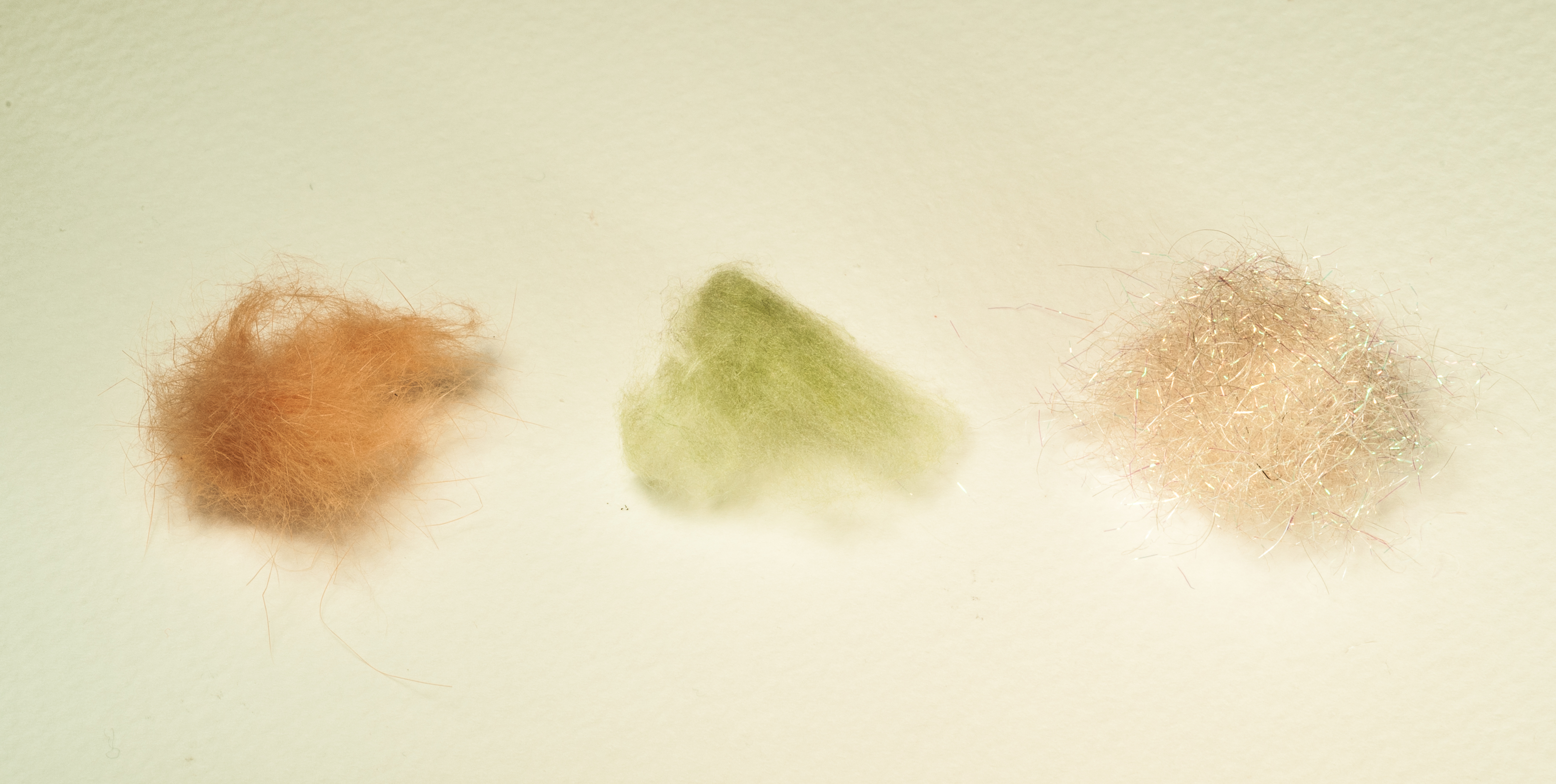 What are the two dubbings on the left for? Hard to tell by just looking. The dubbing on the right, though, the creamy colored one (Arizona Diamond Dubbing) is easy to pin down: it's plainly about adding sparkle to a fly.
What are the two dubbings on the left for? Hard to tell by just looking. The dubbing on the right, though, the creamy colored one (Arizona Diamond Dubbing) is easy to pin down: it's plainly about adding sparkle to a fly.
It logically follows that the floating types should go into floating flies, such as dry flies and floating emerger–patterns (some emerger–flies only half float, a small number don't float at all), and that absorbent dubbings should go into flies designed to sink, nymphs and streamers primarily. Most of the time, that's exactly how this works. But you may choose to ignore logic on occasion, and you may have good reasons for doing so.
For example, Super–Fine Dry Fly Dubbing, a buoyant synthetic dubbing, makes perfect sense for dry flies. But it's got a flat, natural look (which, mostly, is great)—what if you want a little flash, to attract a trout's notice or imitate the gleaming exoskeleton of a beetle or ant? The solution: blend some sparkling Ice Dub or Arizona Diamond Dubbing (both neutral materials, really, neither particularly buoyant nor absorbent) into the Super Fine. Now you have a buoyant dubbing that shines.
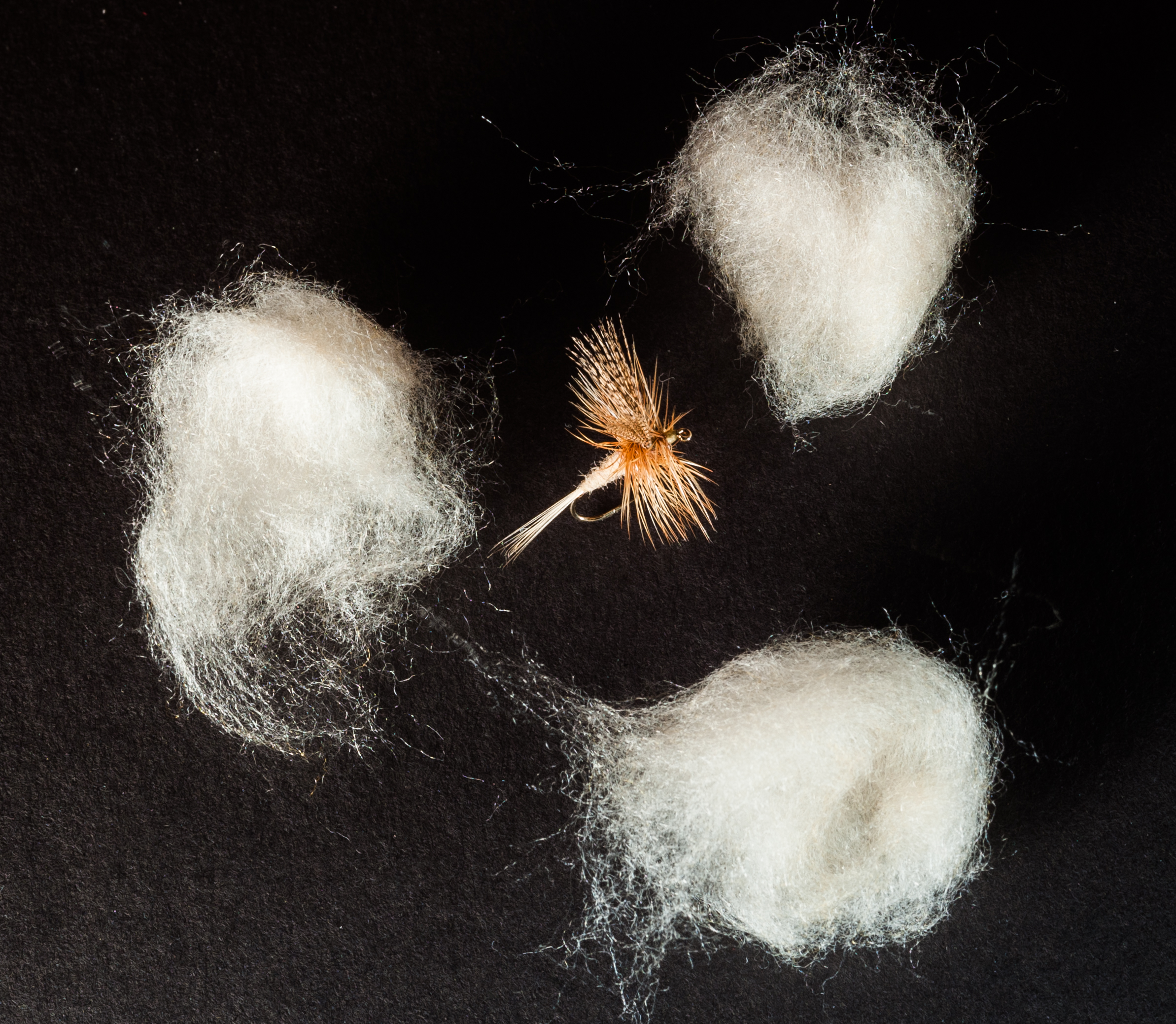 In the center here is the old, elegant Light Cahill dry fly, tied with its traditional badger under–fur body. But the cream–colored Super–Fine Dry Fly Dubbing surrounding the fly is really the best choice for dubbing the body because it floats better and longer than badger.
In the center here is the old, elegant Light Cahill dry fly, tied with its traditional badger under–fur body. But the cream–colored Super–Fine Dry Fly Dubbing surrounding the fly is really the best choice for dubbing the body because it floats better and longer than badger.
Synthetic dubbings generally float (though some float better than others), while natural dubbings tend to absorb water and sink. There are natural dubbing materials that float (fine wool, for example), but synthetic dubbings for floating flies and natural for sinking is a sound, if general, rule.
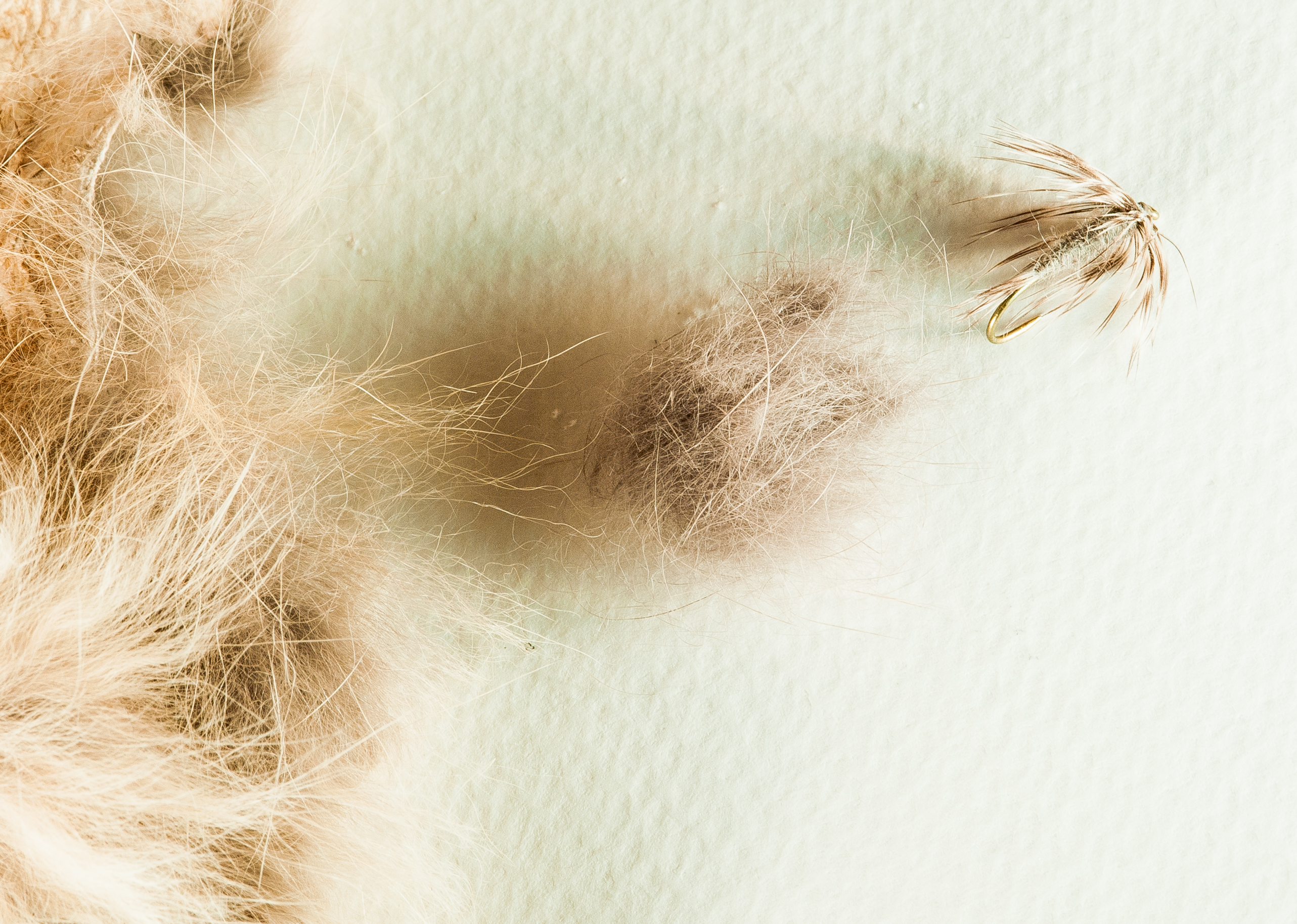 The Gray Nymph, on the right, is a decades-old but still perfectly effective nymph whose body is dubbed with absorbent gray fur, often rabbit. To the left of the fly is a wad of natural–gray rabbit fur—but rabbit comes in a wild range of dyed colors. On the far left is rabbit fur on the hide, the only way tiers were once able to acquire it. And back then, if you wanted colored rabbit fur, you dyed it yourself. Fun . . . (Not really.)
The Gray Nymph, on the right, is a decades-old but still perfectly effective nymph whose body is dubbed with absorbent gray fur, often rabbit. To the left of the fly is a wad of natural–gray rabbit fur—but rabbit comes in a wild range of dyed colors. On the far left is rabbit fur on the hide, the only way tiers were once able to acquire it. And back then, if you wanted colored rabbit fur, you dyed it yourself. Fun . . . (Not really.)
The names of some dubbings state their purpose—what do you suppose Super–Fine Dry Fly Dubbing and Buggy Nymph Dubbing are used for? Some names aren't so clear: Antron Dubbing, Whitlock SLF—see any clues there? (Spoiler: they're both shiny and only mildly buoyant, and therefore can go into sinking flies as is or into floating flies when blended with more–buoyant dubbings.) Obviously, some dubbings require a little homework if you're going to use them wisely. And you can always ask at your local fly shop or call your on–line company and ask for guidance on dubbing, or for that matter, on anything else.
Texture? I prefer coarse dubbings for flies big, stout, or both; fine dubbings for slim and small ones. A coarse dubbing helps you—quickly—build a thick body on an imitation of a dragonfly nymph or adult stonefly. A fine dubbing helps you create a slender fly body, even on a size 22 hook (if, that is, you use only a wisp of the fibers).
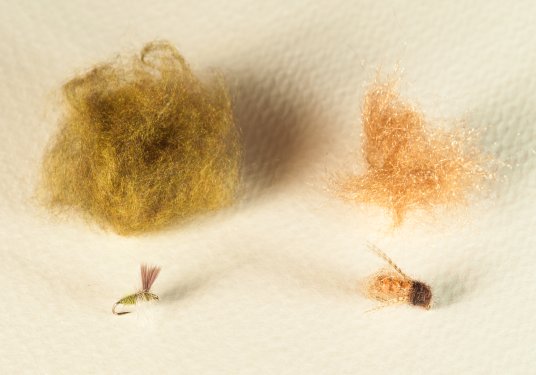 On the left side of this photo is a little Thorax Dun dry fly with a slender body dubbed of the Super–Fine Dry Fly Dubbing behind it. On the right, a Pettis's Pulsating Caddis Pupa, its abdomen made of glass beads veiled in a coarser dubbing with a quiet shine (Buggy Nymph, the same dubbing lying in a little heap behind the fly).
On the left side of this photo is a little Thorax Dun dry fly with a slender body dubbed of the Super–Fine Dry Fly Dubbing behind it. On the right, a Pettis's Pulsating Caddis Pupa, its abdomen made of glass beads veiled in a coarser dubbing with a quiet shine (Buggy Nymph, the same dubbing lying in a little heap behind the fly).
Fiber length? No biggie. That gets us into some fine points, minor points really. Hare's mask, for example, is short, Super–Fine Dry Fly is long. Short or long fibers, doesn't really matter; both work fine for flies of all sizes and types.
***
The bottom line in all this, is this: Though some dubbings are interchangeable with one another, some are not, and the wrong dubbing for a specific fly can be disastrous (Hareline Dubbin for a dry fly, for example, which is rabbit fur, or Wapsi Rabbit Dubbing, which speaks for itself—will absorb water and soon drag the fly down). So do a little research on specific dubbings to insure that you use them appropriately, and as a result the flies you tie will look and perform just as they should.
Click here to hear Skip's interviews on popular podcasts...
*Announcements*
Skip has an essay in Big Sky Journal's annual Fly Fishing issue, called "Montana Hoppers: the Princess and the Brute" released February 1, 2023. Skip rewrote it a bit; I painted and illustrated it here, on our website. Here's the link on our web page to check it out:
Click here to read Skip's essay Montana Hoppers: The Princess and the Brute...
Skip's latest books:
Top 12 Dry Flies for Trout Streams: How, When, and Where to Fish Them, is now available on Amazon as an ebook...check it out! Click on the links below to go to the information page on Top 12 Dry Flies (the link to Amazon is at the bottom of the page...)
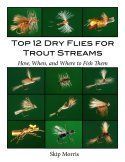 Top 12 Dry Flies for Trout Streams: How, When, and Where to Fish Them
Top 12 Dry Flies for Trout Streams: How, When, and Where to Fish Them
Click here to get more information about
Top 12 Dry Flies for Trout Streams: How, When, and Where to Fish Them (the link to Amazon is at the bottom of the page)...
Top 12 Dry Flies for Trout Streams: How, When, and Where to Fish Them (the link to Amazon is at the bottom of the page)...
Top 12 Nymphs for Trout Streams: How, When, and Where to Fish Them, 2nd Edition, originally published as an e-book only, is now available on Amazon as a paperback...check it out! Click on the links below to go to the information page on Top 12 Nymphs (the link to Amazon is at the bottom of the page...)
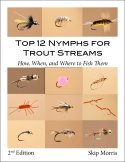 Top 12 Nymphs for Trout Streams: How, When, and Where to Fish Them (2nd Edition)
Top 12 Nymphs for Trout Streams: How, When, and Where to Fish Them (2nd Edition)
Click here to get more information about
Top 12 Nymphs for Trout Streams: How, When, and Where to Fish Them (2nd Edition). . .
Top 12 Nymphs for Trout Streams: How, When, and Where to Fish Them (2nd Edition). . .
Click here to get more information about Skip's e-book,
500 Trout Streams...
500 Trout Streams...
Skip's latest paperback book:
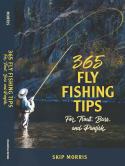 365 Fly Fishing Tips for Trout, Bass, and Panfish
365 Fly Fishing Tips for Trout, Bass, and Panfish
Click here to get more information about Skip's latest book,
365 Tips for Trout, Bass, and Panfish...
365 Tips for Trout, Bass, and Panfish...
Print Skip's chart for FREE:
Skip Morris's Trout-Fly Proportion Chart
Go to Skip Morris's Trout Fly Proportion Chart
Skip's Predator is available to buy...
Skip's ultra-popular Predator—a hit fly for bluegills and other panfishes and largemouth bass (also catches smallmouth bass and trout)—is being tied commercially by the Solitude Fly Company.
The Predator
CLICK HERE to learn more about or to purchase the Predator...
Learn to Tie Skip's Predator
Do you want to tie the Predator?
Tying the Predator
Skip shows you how to tie it on his YouTube Channel link, listed below:
CLICK HERE to see Skip's detailed video on how to tie the Predator...





